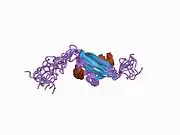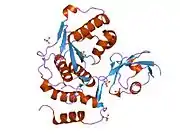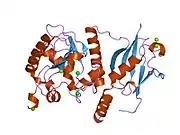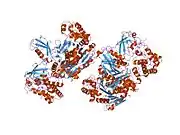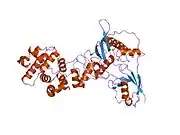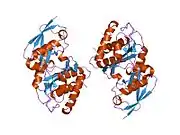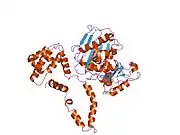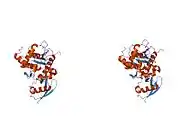SUMO1
Small ubiquitin-related modifier 1 is a protein that in humans is encoded by the SUMO1 gene.[5][6]
Function
This gene encodes a protein that is a member of the SUMO (small ubiquitin-like modifier) protein family. It is a ubiquitin-like protein and functions in a manner similar to ubiquitin in that it is bound to target proteins as part of a post-translational modification system. However, unlike ubiquitin, which is primarily associated with targeting proteins for proteasomal degradation, SUMO1 is involved in a variety of cellular processes, such as nuclear transport, transcriptional regulation, apoptosis, and protein stability. It is not active until the last four amino acids of the carboxy-terminus have been cleaved off. Several pseudogenes have been reported for this gene. Alternate transcriptional splice variants encoding different isoforms have been characterized.[7]
Most cleft genes have a sumoylation component.[8] Analysis of chromosomal anomalies in patients has led to the identification and confirmation of SUMO1 as a cleft lip and palate locus.[9]
Interactions
Small ubiquitin-related modifier 1 has been shown to interact with:
Role in the heart
Heart failure is a process by which the heart’s pumping ability is significantly weakened, so that the body is unable to get adequate circulation. A weakened heart results in symptoms of fatigue, decreased exercise tolerance and shortness of breath. Patients with heart failure have a significantly increased risk of death compared to people with normal heart function. Heart failure is a major public health concern, as its incidence is on the rise worldwide, and is a leading cause of death in developed nations [27]
SUMO 1 is a key component in cardiac function, since it helps regulate calcium homeostasis in the mitochondria of heart cells. SUMO 1 is associated with another essential cardiac protein called sarco/endoplasmic reticulum Ca2+ ATPase, or SERCA2A. SERCA is a transmembrane protein located in the sarcoplasmic reticulum of cardiac cells. Its main function is to regulate the discharge and uptake of intracellular calcium between the cytosol and the lumen of the sarcoplasmic reticulum. Calcium is an essential factor for the development of cardiac myocyte contraction and relaxation. Thus, the management of intracellular calcium homeostasis by SERCA2A is critical for overall cardiac performance.[28] Normally, SUMO 1 activates and stabilizes SERCA2A by binding at lysine resides 480 and 585. The interaction between SUMO 1 and SERCA2A is crucial for regulating calcium levels inside cardiac myocytes. Reduction in SUMO 1 protein reduces SERCA2A, and thus efficient calcium handling in patients with failing hearts.[29]
As a drug target
SUMO 1 may be an important therapeutic target to help improve cardiac performance in patients with heart failure. In a mouse model, the introduction of SUMO 1 through gene therapy was associated with improved activity of SERCA2A, which resulted in improved cardiac function through an augmentation of cardiac contractility.[29] Furthermore, overexpression of SUMO 1 resulted in accelerated calcium uptake, providing further evidence regarding its importance in maintaining adequate calcium levels in heart cells.[29]
See also
References
- GRCh38: Ensembl release 89: ENSG00000116030 - Ensembl, May 2017
- GRCm38: Ensembl release 89: ENSMUSG00000026021 - Ensembl, May 2017
- "Human PubMed Reference:". National Center for Biotechnology Information, U.S. National Library of Medicine.
- "Mouse PubMed Reference:". National Center for Biotechnology Information, U.S. National Library of Medicine.
- Shen Z, Pardington-Purtymun PE, Comeaux JC, Moyzis RK, Chen DJ (September 1996). "UBL1, a human ubiquitin-like protein associating with human RAD51/RAD52 proteins". Genomics. 36 (2): 271–9. doi:10.1006/geno.1996.0462. PMID 8812453.
- Okura T, Gong L, Kamitani T, Wada T, Okura I, Wei CF, Chang HM, Yeh ET (November 1996). "Protection against Fas/APO-1- and tumor necrosis factor-mediated cell death by a novel protein, sentrin". Journal of Immunology. 157 (10): 4277–81. doi:10.4049/jimmunol.157.10.4277. PMID 8906799. S2CID 38606511.
- "Entrez Gene: SUMO1 SMT3 suppressor of mif two 3 homolog 1 (S. cerevisiae)".
- Pauws E, Stanier P (December 2007). "FGF signalling and SUMO modification: new players in the aetiology of cleft lip and/or palate". Trends in Genetics. 23 (12): 631–40. doi:10.1016/j.tig.2007.09.002. PMID 17981355.
- Dixon MJ, Marazita ML, Beaty TH, Murray JC (2011). "Cleft lip and palate: understanding genetic and environmental influences". Nature Reviews Genetics (12) 167-178.
- "Molecular Interaction Database". Archived from the original on 2006-05-06.
- Lin DY, Shih HM (July 2002). "Essential role of the 58-kDa microspherule protein in the modulation of Daxx-dependent transcriptional repression as revealed by nucleolar sequestration". The Journal of Biological Chemistry. 277 (28): 25446–56. doi:10.1074/jbc.M200633200. PMID 11948183.
- Ryu SW, Chae SK, Kim E (December 2000). "Interaction of Daxx, a Fas binding protein, with sentrin and Ubc9". Biochemical and Biophysical Research Communications. 279 (1): 6–10. doi:10.1006/bbrc.2000.3882. PMID 11112409.
- Ivanchuk SM, Mondal S, Rutka JT (June 2008). "p14ARF interacts with DAXX: effects on HDM2 and p53". Cell Cycle. 7 (12): 1836–50. doi:10.4161/cc.7.12.6025. PMID 18583933.
- Kang ES, Park CW, Chung JH (December 2001). "Dnmt3b, de novo DNA methyltransferase, interacts with SUMO-1 and Ubc9 through its N-terminal region and is subject to modification by SUMO-1". Biochemical and Biophysical Research Communications. 289 (4): 862–8. doi:10.1006/bbrc.2001.6057. PMID 11735126.
- Minty A, Dumont X, Kaghad M, Caput D (November 2000). "Covalent modification of p73alpha by SUMO-1. Two-hybrid screening with p73 identifies novel SUMO-1-interacting proteins and a SUMO-1 interaction motif". The Journal of Biological Chemistry. 275 (46): 36316–23. doi:10.1074/jbc.M004293200. PMID 10961991.
- Lee BH, Yoshimatsu K, Maeda A, Ochiai K, Morimatsu M, Araki K, Ogino M, Morikawa S, Arikawa J (December 2003). "Association of the nucleocapsid protein of the Seoul and Hantaan hantaviruses with small ubiquitin-like modifier-1-related molecules". Virus Research. 98 (1): 83–91. doi:10.1016/j.virusres.2003.09.001. PMID 14609633.
- Kahyo T, Nishida T, Yasuda H (September 2001). "Involvement of PIAS1 in the sumoylation of tumor suppressor p53". Molecular Cell. 8 (3): 713–8. doi:10.1016/S1097-2765(01)00349-5. PMID 11583632.
- Kamitani T, Nguyen HP, Kito K, Fukuda-Kamitani T, Yeh ET (February 1998). "Covalent modification of PML by the sentrin family of ubiquitin-like proteins". The Journal of Biological Chemistry. 273 (6): 3117–20. doi:10.1074/jbc.273.6.3117. PMID 9452416.
- Tatham MH, Kim S, Yu B, Jaffray E, Song J, Zheng J, Rodriguez MS, Hay RT, Chen Y (August 2003). "Role of an N-terminal site of Ubc9 in SUMO-1, -2, and -3 binding and conjugation". Biochemistry. 42 (33): 9959–69. doi:10.1021/bi0345283. PMID 12924945.
- Gong L, Li B, Millas S, Yeh ET (April 1999). "Molecular cloning and characterization of human AOS1 and UBA2, components of the sentrin-activating enzyme complex". FEBS Letters. 448 (1): 185–9. doi:10.1016/S0014-5793(99)00367-1. PMID 10217437. S2CID 7756078.
- Wang YT, Chuang JY, Shen MR, Yang WB, Chang WC, Hung JJ (July 2008). "Sumoylation of specificity protein 1 augments its degradation by changing the localization and increasing the specificity protein 1 proteolytic process". Journal of Molecular Biology. 380 (5): 869–85. doi:10.1016/j.jmb.2008.05.043. PMID 18572193.
- Hardeland U, Steinacher R, Jiricny J, Schär P (March 2002). "Modification of the human thymine-DNA glycosylase by ubiquitin-like proteins facilitates enzymatic turnover". The EMBO Journal. 21 (6): 1456–64. doi:10.1093/emboj/21.6.1456. PMC 125358. PMID 11889051.
- Liou ML, Liou HC (April 1999). "The ubiquitin-homology protein, DAP-1, associates with tumor necrosis factor receptor (p60) death domain and induces apoptosis". The Journal of Biological Chemistry. 274 (15): 10145–53. doi:10.1074/jbc.274.15.10145. PMID 10187798.
- Mao Y, Desai SD, Liu LF (August 2000). "SUMO-1 conjugation to human DNA topoisomerase II isozymes". The Journal of Biological Chemistry. 275 (34): 26066–73. doi:10.1074/jbc.M001831200. PMID 10862613.
- Ewing RM, Chu P, Elisma F, Li H, Taylor P, Climie S, McBroom-Cerajewski L, Robinson MD, O'Connor L, Li M, Taylor R, Dharsee M, Ho Y, Heilbut A, Moore L, Zhang S, Ornatsky O, Bukhman YV, Ethier M, Sheng Y, Vasilescu J, Abu-Farha M, Lambert JP, Duewel HS, Stewart II, Kuehl B, Hogue K, Colwill K, Gladwish K, Muskat B, Kinach R, Adams SL, Moran MF, Morin GB, Topaloglou T, Figeys D (2007). "Large-scale mapping of human protein-protein interactions by mass spectrometry". Molecular Systems Biology. 3 (1): 89. doi:10.1038/msb4100134. PMC 1847948. PMID 17353931.
- Shen Z, Pardington-Purtymun PE, Comeaux JC, Moyzis RK, Chen DJ (October 1996). "Associations of UBE2I with RAD52, UBL1, p53, and RAD51 proteins in a yeast two-hybrid system". Genomics. 37 (2): 183–6. doi:10.1006/geno.1996.0540. PMID 8921390.
- Schwartz RJ, Yeh ET (2012). "Weighing in on heart failure: the role of SERCA2a SUMOylation". Circulation Research. 110 (2): 198–9. doi:10.1161/RES.0b013e318246f187. PMID 22267837.
- Periasamy M, Huke S (2001). "SERCA pump level is a critical determinant of Ca(2+)homeostasis and cardiac contractility". Journal of Molecular and Cellular Cardiology. 33 (6): 1053–63. doi:10.1006/jmcc.2001.1366. PMID 11444913.
- Kho C, Lee A, Jeong D, Oh JG, Chaanine AH, Kizana E, Park WJ, Hajjar RJ (2011). "SUMO1-dependent modulation of SERCA2a in heart failure". Nature. 477 (7366): 601–5. Bibcode:2011Natur.477..601K. doi:10.1038/nature10407. PMC 3443490. PMID 21900893.
Further reading
- Cookson MR (January 2003). "Pathways to Parkinsonism". Neuron. 37 (1): 7–10. doi:10.1016/S0896-6273(02)01166-2. PMID 12526767. S2CID 14513509.
- Boddy MN, Howe K, Etkin LD, Solomon E, Freemont PS (September 1996). "PIC 1, a novel ubiquitin-like protein which interacts with the PML component of a multiprotein complex that is disrupted in acute promyelocytic leukaemia". Oncogene. 13 (5): 971–82. PMID 8806687.
- Bonaldo MF, Lennon G, Soares MB (September 1996). "Normalization and subtraction: two approaches to facilitate gene discovery". Genome Research. 6 (9): 791–806. doi:10.1101/gr.6.9.791. PMID 8889548.
- Shen Z, Pardington-Purtymun PE, Comeaux JC, Moyzis RK, Chen DJ (October 1996). "Associations of UBE2I with RAD52, UBL1, p53, and RAD51 proteins in a yeast two-hybrid system". Genomics. 37 (2): 183–6. doi:10.1006/geno.1996.0540. PMID 8921390.
- Matunis MJ, Coutavas E, Blobel G (December 1996). "A novel ubiquitin-like modification modulates the partitioning of the Ran-GTPase-activating protein RanGAP1 between the cytosol and the nuclear pore complex". The Journal of Cell Biology. 135 (6 Pt 1): 1457–70. doi:10.1083/jcb.135.6.1457. PMC 2133973. PMID 8978815.
- Mahajan R, Delphin C, Guan T, Gerace L, Melchior F (January 1997). "A small ubiquitin-related polypeptide involved in targeting RanGAP1 to nuclear pore complex protein RanBP2". Cell. 88 (1): 97–107. doi:10.1016/S0092-8674(00)81862-0. PMID 9019411. S2CID 17819277.
- Lapenta V, Chiurazzi P, van der Spek P, Pizzuti A, Hanaoka F, Brahe C (March 1997). "SMT3A, a human homologue of the S. cerevisiae SMT3 gene, maps to chromosome 21qter and defines a novel gene family". Genomics. 40 (2): 362–6. doi:10.1006/geno.1996.4556. PMID 9119407.
- Kamitani T, Nguyen HP, Yeh ET (May 1997). "Preferential modification of nuclear proteins by a novel ubiquitin-like molecule". The Journal of Biological Chemistry. 272 (22): 14001–4. doi:10.1074/jbc.272.22.14001. PMID 9162015.
- Mahajan R, Gerace L, Melchior F (January 1998). "Molecular characterization of the SUMO-1 modification of RanGAP1 and its role in nuclear envelope association". The Journal of Cell Biology. 140 (2): 259–70. doi:10.1083/jcb.140.2.259. PMC 2132567. PMID 9442102.
- Howe K, Williamson J, Boddy N, Sheer D, Freemont P, Solomon E (January 1998). "The ubiquitin-homology gene PIC1: characterization of mouse (Pic1) and human (UBL1) genes and pseudogenes". Genomics. 47 (1): 92–100. doi:10.1006/geno.1997.5091. PMID 9465300.
- Bayer P, Arndt A, Metzger S, Mahajan R, Melchior F, Jaenicke R, Becker J (July 1998). "Structure determination of the small ubiquitin-related modifier SUMO-1". Journal of Molecular Biology. 280 (2): 275–86. doi:10.1006/jmbi.1998.1839. PMID 9654451.
- Desterro JM, Rodriguez MS, Hay RT (August 1998). "SUMO-1 modification of IkappaBalpha inhibits NF-kappaB activation". Molecular Cell. 2 (2): 233–9. doi:10.1016/S1097-2765(00)80133-1. PMID 9734360.
- Juo P, Kuo CJ, Yuan J, Blenis J (September 1998). "Essential requirement for caspase-8/FLICE in the initiation of the Fas-induced apoptotic cascade". Current Biology. 8 (18): 1001–8. doi:10.1016/S0960-9822(07)00420-4. PMID 9740801. S2CID 18129508.
- Kamitani T, Kito K, Nguyen HP, Wada H, Fukuda-Kamitani T, Yeh ET (October 1998). "Identification of three major sentrinization sites in PML". The Journal of Biological Chemistry. 273 (41): 26675–82. doi:10.1074/jbc.273.41.26675. PMID 9756909.
- Duprez E, Saurin AJ, Desterro JM, Lallemand-Breitenbach V, Howe K, Boddy MN, Solomon E, de Thé H, Hay RT, Freemont PS (February 1999). "SUMO-1 modification of the acute promyelocytic leukaemia protein PML: implications for nuclear localisation". Journal of Cell Science. 112 ( Pt 3) (3): 381–93. doi:10.1242/jcs.112.3.381. PMID 9885291.
- Chen A, Mannen H, Li SS (December 1998). "Characterization of mouse ubiquitin-like SMT3A and SMT3B cDNAs and gene/pseudogenes". Biochemistry and Molecular Biology International. 46 (6): 1161–74. doi:10.1080/15216549800204722. PMID 9891849. S2CID 45939730.
- Okuma T, Honda R, Ichikawa G, Tsumagari N, Yasuda H (January 1999). "In vitro SUMO-1 modification requires two enzymatic steps, E1 and E2". Biochemical and Biophysical Research Communications. 254 (3): 693–8. doi:10.1006/bbrc.1998.9995. PMID 9920803.
- Liou ML, Liou HC (April 1999). "The ubiquitin-homology protein, DAP-1, associates with tumor necrosis factor receptor (p60) death domain and induces apoptosis". The Journal of Biological Chemistry. 274 (15): 10145–53. doi:10.1074/jbc.274.15.10145. PMID 10187798.
External links
- SUMO1 human gene location in the UCSC Genome Browser.
- SUMO1 human gene details in the UCSC Genome Browser.








